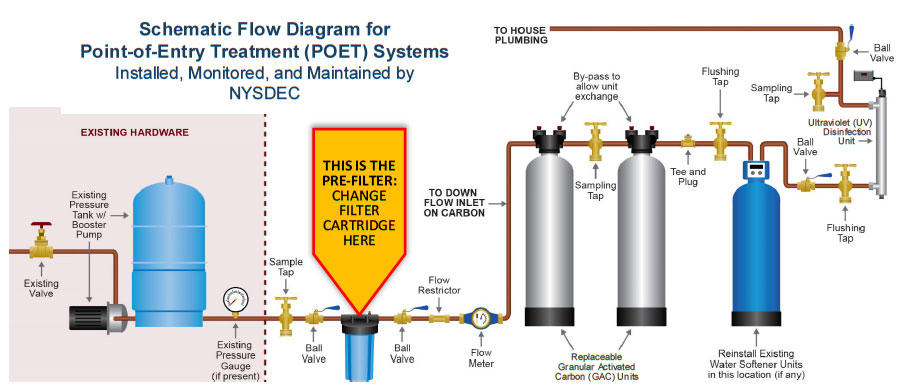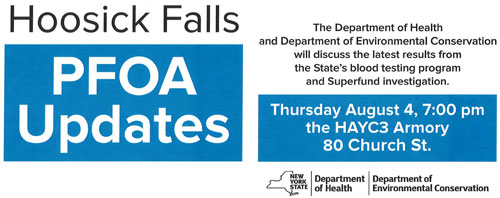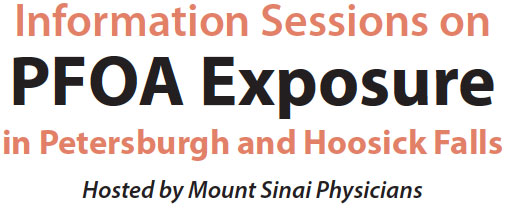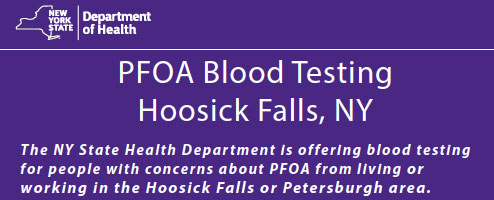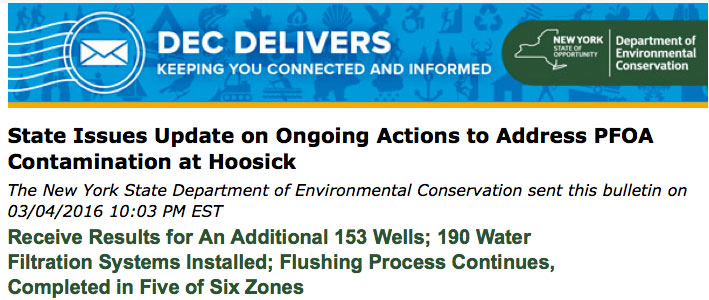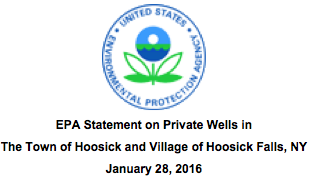WATER RELATED INFORMATION - All Town of Hoosick
All Town of Hoosick | Proposed Municipal Water & Sewer Expansion Project. | Hoosick Falls Water Site
========== 2021 =========
12 Sept. 2021
22 Apr 2021
DEC Invites Public Comment
About Remedy for Village of Hoosick Falls Water Supply
Virtual Public Meeting Scheduled
========== 2020 =========
========== 2019 =========
2 Jul 2019
NYSDEC Provides Update on Status of Cleanup of PFAS Contamination in the Hoosick Area
========== 2018 =========
========= 2017==========
9 September 2017
Action Will Provide Financial Relief to Both Individuals and Local Governments Impacted by Severe Summer Storms
5 September 2017
PFOA Community Health Questionnaire
13 August 2017

EPA Adds Saint-Gobain Performance Plastics Site in Hoosick Falls, N.Y. to the Federal Superfund List
Contact: Elias Rodriguez, (212) 637-3664, rodriguez.elias@epa.gov
(New York, N.Y. – July 31, 2017) The U.S. Environmental Protection Agency has added the Saint-Gobain Performance Plastics site in the Village of Hoosick Falls, N.Y. to its Superfund National Priorities List (NPL) of the country's most hazardous waste sites. Groundwater at the Saint-Gobain Performance Plastics facility, located at 14 McCaffrey Street, and in other locations in Hoosick Falls is contaminated with Perfluorooctanoic Acid (PFOA) and Trichloroethylene (TCE). Adding the site to the federal Superfund list will allow the EPA to work with New York State to ensure that the contamination is cleaned up and that people’s health is protected.
“My goal as Administrator is to restore the Superfund program to its rightful place at the center of the agency’s core mission. Today, we are adding sites to the Superfund National Priorities List to ensure they are cleaned up for the benefit of these communities,” said EPA Administrator Scott Pruitt, “When we clean up these sites, we make communities healthier places to live and clear the way for development and increased economic activity.”
The McCaffrey Street facility was built in 1961, and had been used to manufacture circuit board laminates, polytetrafluoroethylene (PTFE)-coated fiberglass and other PTFE products. In 1999, Saint-Gobain Performance Plastics purchased the facility and began operations there, using PFOA in its manufacturing process. PFOA belongs to a group of chemicals used to make household and commercial products that resist heat and chemical reactions and repel oil, stains, grease and water. PFOA was widely used in non-stick pots and pans, stain-resistant carpets, and water-resistant outerwear. In 2006, the EPA reached a nationwide agreement with eight manufacturers to phase out the production and use of PFOA. These manufacturers stopped using PFOA in 2015. PFOA is persistent in the environment and can pose adverse effects to human health and the environment. TCE is a volatile organic compound widely used as an industrial solvent. Exposure to TCE can have adverse health impacts, including liver damage and increased risk of cancer.
After PFOA was discovered in the public drinking water supply, a carbon filtration system was installed on the Village of Hoosick Falls water supply wells to treat the water and protect consumers. PFOA was also discovered in private wells, and special systems called “point of entry treatment systems,” or POETS, have been installed on a number of private drinking water wells. The New York State Department of Environmental Conservation (NYSDEC) and Department of Health, with input from the EPA, have overseen measures to address the drinking water contamination.
· In January 2016, the NYSDEC added the Saint-Gobain site to New York State’s Superfund list and requested that the EPA include the site on EPA’s federal Superfund list.
· In April and May 2016, the EPA installed monitoring wells to sample groundwater at and around the Saint-Gobain Performance Plastics facility (McCaffrey Street facility) and sampled the Village water supply wells. The EPA also collected soil samples from the McCaffrey Street facility, Village ballfields and recreational areas.
· In June 2016, the NYSDEC entered into a legal agreement with Saint-Gobain Performance Plastics Corporation and Honeywell International Inc. and initiated a study of the nature and extent of contamination at the site.
· In September 2016, the EPA proposed adding the Saint-Gobain Performance Plastics site to the federal Superfund list.
The EPA has determined that the appropriate course of action to address contamination from the Saint-Gobain facility is to list the site on the NPL. The EPA took public comment and considered public input before finalizing the decision. The EPA is coordinating all investigation and cleanup efforts with New York State. To learn more about the Saint-Gobain Performance Plastics Superfund site, please visit:
https://www.epa.gov/ny/hoosick-falls-water-contamination
For Federal Register notices and supporting documents for final and proposed sites, visit: https://www.epa.gov/superfund/current-npl-updates-new-proposed-npl-sites-and-new-npl-sites
Today’s NPL update follows the announcement of the Superfund Task Force recommendations to improve the Superfund program.
The task force’s recommendations focused on five overarching goals: expediting cleanup and remediation, reinvigorating cleanup and reuse efforts by potentially responsible parties, encouraging private investment to facilitate cleanup and reuse, promoting redevelopment and community revitalization and engaging with partners and stakeholders.
Work to prioritize and reinvigorate the program by the task force has been initiated and will be ongoing into the future. The Superfund Task Force Recommendations can be viewed at https://www.epa.gov/superfund/superfund-task-force-recommendations.
Follow EPA Region 2 on Twitter at http://twitter.com/eparegion2 and visit our Facebook page,
http://facebook.com/eparegion2.
8 July 2017
NSF Awards Bennington College Grant to
Expand Study of PFOA
Bennington VT -- Bennington College Faculty Members David Bond, Janet Foley, and Tim Schroeder have been awarded a $300,000 National Science Foundation (NSF) grant to deepen and expand the College’s response to PFOA contamination in New York and Vermont.
“Support from the NSF will allow Bennington College to do what we do best: confront the big problems of our time and put students and faculty to work crafting new insights and new solutions in real time,” said David Bond, Associate Director of the Center for the Advancement of Public Action (CAPA) at Bennington College.
PFOA was discovered last year in alarming concentrations in the groundwater of several towns in Upstate New York and Southern Vermont. Once used in plastics manufacturing across the region, PFOA is now coming under increasing scrutiny as a widespread environmental toxin. Through new courses, new collaborations, and new research, this NSF-funded project—“Understanding PFOA”—will bring science education at Bennington College into conversation with unfolding local and national concerns about PFOA.
“This grant will allow us to more effectively apply the Bennington philosophy of learning by doing. Rather than just reading case studies of groundwater contamination incidents, our students will be actively investigating a local problem,” said Geology Faculty Member Tim Schroeder. “Students will learn about the science of PFOA contamination and, by visiting impacted communities, also learn why science matters.”
This project will equip a handful of science classes in chemistry, geology, and environmental studies at Bennington College to produce independent data on PFOA contamination.
“We are very excited to be able to follow up on strategies for involving students in the next phase of community involvement with the PFOA contamination in our area,” said Chemistry Faculty Member Janet Foley. “We hope to develop multiple mechanisms for students to engage in this issue, such as incorporating PFOA modules in our science classes, training students in GIS to develop visual mapping of data, and proteomic studies with yeast to explore the effects of PFOA from a molecular point of view. This issue is an opportunity for students to see that by integrating knowledge with real-life problems, they can make real changes in the world.”
Bond, Foley, and Schroeder are joined on the grant by Associate Professor of Chemistry Laura MacManus-Spencer of Union College.
“This project will provide a crucial home base for the growing network of research scientists and science educators in our region concerned about PFOA,” said MacManus-Spencer. “From university laboratories to high school classrooms, this project will help organize and apply the scientific resources of our region to the urgent questions being raised about PFOA by local residents.”
This project also teams up with the New York State Department of Environmental Conservation (NYS DEC) and the Vermont Department of Environmental Conservation (VT DEC) to share research projects and findings on PFOA across state borders.
In many ways, PFOA represents a new kind of environmental problem. Once a key ingredient in the manufacture of high-performance plastics like Teflon, PFOA is now coming into focus as a subtle environmental toxin since low-level exposure has been correlated to a number of adverse health effects. PFOA resists natural degradation, is chemically stable in water for nearly a century, is highly mobile once released into the environment, and is readily absorbed by the body when consumed, where it is unsafely housed for 3–5 years.
Although PFOA was voluntarily phased out of manufacturing in the US in 2015, a tremendous amount remains in the environment. The Environmental Working Group estimates that over 5 million Americans currently rely on drinking water with harmful levels of PFOA. As the EPA summarizes, “the toxicity, mobility, and bioaccumulation” of PFOA poses difficult questions for safeguarding human health in areas where it has been released into the environment.
“Bridging local questions about PFOA contamination with the analytic resources and manpower of the science classroom, this project showcases the civic value of science in times of new environmental challenges and toxic uncertainties” Bond said. “It promises a new educational model for colleges and universities to respond to nearby environmental problems.”
This current grant builds on a previous RAPID NSF grant Bennington College received in March of 2016. As PFOA was discovered in Hoosick Falls, NY, in 2015 and in Bennington, VT, in 2016, Bennington College designed and offered a new course on the chemical properties, environmental pathways, and policy concerns surrounding PFOA. Alongside Bennington students, this class was opened to high school teachers, nurses, local journalists, and community members from Hoosick Falls and Bennington. This class was offered as a primer on PFOA that could equip students and citizens alike to better navigate the very complicated science of PFOA, to produce data more attuned to local concerns, and to demand better protections for water resources moving forward. This additional NSF support will enable Bennington to continue offering this course once a year for three years.
In the course, students also learned how to produce and interpret original data on PFOA contamination. Taking public concerns around PFOA as analytic prompts, students and faculty designed research projects that could produce independent data to answer community questions. For example, residents asked if there might be any PFOA in local maple syrup. After tapping two trees within one mile of a former plastics plant, laboratory analysis found low levels of PFOA in the maple sap (about 8 ppt). Other residents asked if there might be any residual PFOA in the water pipes of their home, which are located after the carbon filtration system and thus might be a continued source of PFOA exposure. Laboratory analysis found no detectable PFOA in water sampled from the kitchen faucet in homes in Hoosick Falls and Bennington with private wells that have high levels of PFOA.
Many local residents also expressed concern about highly divergent readings among immediate neighbors—the well of one house has alarming levels of PFOA while the well of the house next door does not have detectable levels. Monitoring two neighborhoods with divergent readings over the course of one year has not revealed a coherent pattern: analysis has indicated significant fluctuation in one neighborhood and relative stability in another. Continued NSF support will enable Bennington College to continue monitoring these neighborhoods as well as continue using the scientific resources of the college to help answer new community concerns.
Bennington College’s pioneering response to PFOA contamination has garnered national attention. In addition to local and national media coverage of the project, Bond, Foley, and Schroeder have given invited presentations on their work engaging PFOA to environmental scientists and faculty at University of Massachusetts Amherst, Northeastern University, and Williams College, as well as to environmental policymakers and elected officials in Vermont, New York, and Massachusetts. They’ve also given numerous presentations to residents and local leaders in Hoosick Falls, NY, and Bennington, VT. In May 2017, Bennington College also hosted a conference of 150 regional high school students and teachers to learn more about engaging PFOA in an AP science classroom.
About Bennington College
Bennington College is a liberal arts college in southern Vermont with a long tradition of engaging science and the humanities in the contemporary world. The Center for the Advancement of Public Action (CAPA) at Bennington College is furthering the educational philosophy and pedagogy of the College by connecting classroom learning to hands-on engagements with a wide range of current issues like international conflict and leadership, art in the public realm, incarceration in America, and, increasingly, our region’s food, energy, and water systems. Founded in 2011, CAPA teaches the essential capacities needed to develop an educated and emboldened citizenry. Drawing together the deep artistic and analytic resources of Bennington College and collaborating with existing public and private organizations, CAPA leverages the classroom as a new kind of laboratory for creative problem solving and innovation.

NYS Department of Health
PFOA in Drinking Water in the Village of Hoosick Falls and Town of Hoosick
Individuals can obtain a copy of the Cancer Incidence Investigation
Cancer Investigation
Information about our upcoming public availability sessions, as well as links to PDFs of the full report and the summary of the report findings.
Individuals can access the report at the following link:
http://www.health.ny.gov/environmental/investigations/hoosick/.
Specific links to those PDFs can be found here:
http://www.health.ny.gov/environmental/investigations/hoosick/docs/cancer_report.pdf
and here:
http://www.health.ny.gov/environmental/investigations/hoosick/docs/cancer_report_summary.pdf.
10 Jun 2017
Download the complete above document with Maps as a PDF (16 pages) ![]()
![]()
For Immediate Release: 02/09/17
DEC Contact: Sean Mahar | (518) 402-8000
Press Office | PressOffice@dec.ny.gov
DOH Contact: Gary Holmes (518) 474-7354 ext. 1
Press@health.ny.gov
2.09.17
STATE DEPARTMENTS OF ENVIRONMENTAL CONSERVATION AND HEALTH DIRECT HONEYWELL TO TEST FOR VOLITILE ORGANIC COMPOUNDS NEAR FORMER HOOSICK FALLS FACILITY
The New York State Departments of Environmental Conservation (DEC) and Health (DOH) announced today that they have directed Honeywell to immediately conduct a soil vapor intrusion investigation following the detection of the volatile organic compounds (VOC) trichloroethylene (TCE) and 1,1,1-trichloroethane (111-TCA), at the company’s former John St. facility. Soil vapor intrusion refers to a process by which contamination beneath the ground’s surface moves into the indoor air of overlying buildings. These investigations are routinely completed near sites where VOCs, or chemicals that can easily enter the air as gases from some solids or liquids, are identified to help determine if any actions are required to protect residents from potential exposure.(continued...)
![]()
Dear Mayor Borge:
Based on analytical results of testing on water samples collected from the recently installed full-capacity granular activated carbon (GAC) treatment system and from the clearwell at the Village of Hoosick Falls Water Treatment Facility, the New York State Department of Health (NYSDOH) has determined that the full-capacity system is operating in accordance with the approved design and producing water with non-detectable levels of PFOA. (continued...)
2 0 1 6
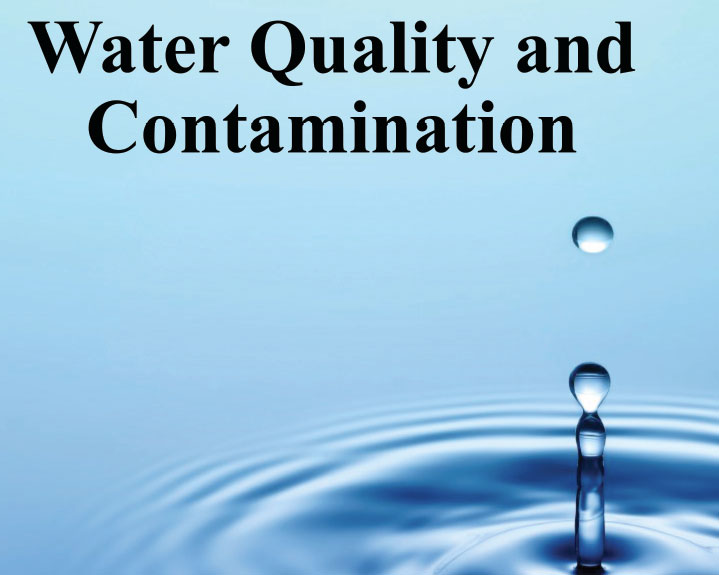
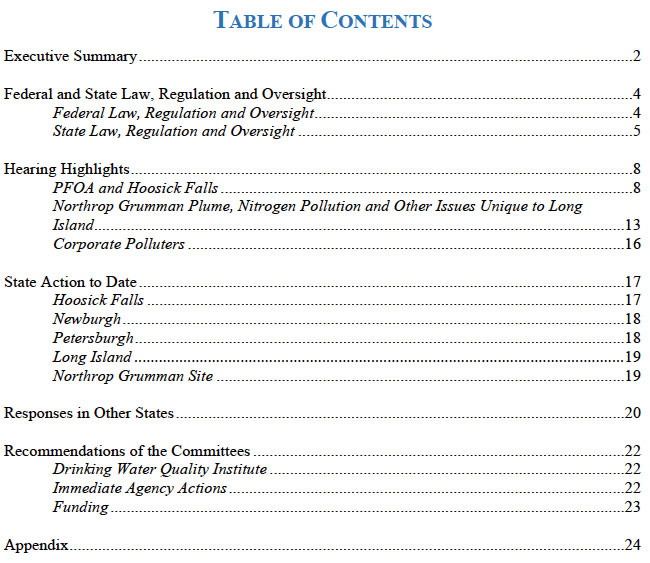
![]()
============= 2016 ===========
Point-of-Entry Treatment (POET)
Homeowner System Guide
Download
Maintenance Guide
Download
![]()
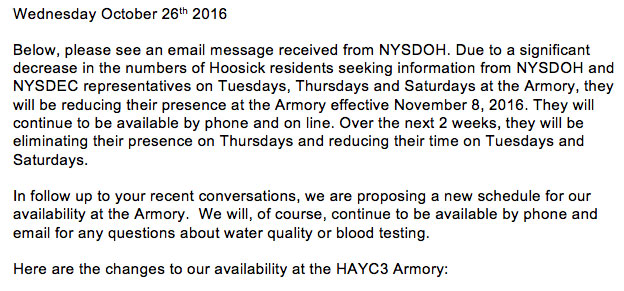
Summary: DEC fish contaminant monitoring staff and DOH fish consumption advisory staff recommend that fish from waters contaminated by perfluorooctanoic acid (PFOA) at Petersburgh and Hoosick Falls and from waters contaminated by perfluorooctane sulfonate (PFOS) at Newburgh be collected and analyzed to provide an initial assessment of the potential bioaccumulation and risk posed by these and other perfluorinated compounds (PFCs).
Proposed Municipal Water & Sewer Expansion Project
Drinking Water Health Advisories
for PFOA and PFOS (LINK)
Also...
Honeywell to begin local investigation at John St and River Road sites. Nearby property owners may receive the Attached Letter and or receive a visit from a Honeywell representative.

FREQUENTLY ASKED QUESTIONS REGARDING
POOLS AND HOT TUBS IN THE HOOSICK FALLS AREA
May 9, 2016
![]()
Mayor Borge:
Please find our April 6 response to your Feb. 2 letter you sent EPA.
Water Valves(10 Mar 2016)
I received a call a few minutes ago from Eugene Leff who is the Deputy Commissioner at NYS DEC explaining the issue with the valves that were installed as a part of the POET systems as reported this morning in the news. The valves emit lead after a period of time and were never designed to be used with systems for drinking water. He could not tell me how many homes were affected but it was many. They have made changing these valves the new priority. As a result of the priority change the installation of new POET systems will slow down temporally.
Homes that have had new POET systems installed should not drink or cook with the water until given the all clear by DEC. They need to use the free bottled water that is available at Tops.
New York State Announces Progress Regarding Water Filtration Systems in Town of Hoosick and Village of Hoosick Falls
The State Department of Health and the Department of Environmental Conservation today announced progress to address perfluorooctanoic acid (PFOA) contamination the public water system in the Village of Hoosick Falls and in private wells in the Town of Hoosick.
Today, the village carbon filtration system at the municipal water treatment plant was successfully installed and the distribution system will be flushed with clean, filtered water, to remove residual PFOA.
HOOSICK FALLS CARBON TREATMENT
SYSTEM
NOW OPERATIONAL
The newly-installed carbon filtration system at the municipal water treatment plant is fully operational and Village officials have begun pumping water through the system and into the Village's water distribution system, announced Village Mayor David Borge.
![]()
FORMS
Private Well Sampling Request Form
2016 Water Filter System Install Fact Sheet
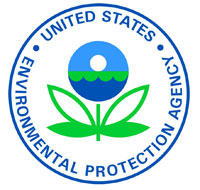
Today (Feb. 22) EPA issued Community Update Fact Sheet No. 2 which discusses the agency’s plans to sample the Hoosick Falls Athletic Field. The fact sheet and additional information about Hoosick Falls water contamination can be found at: http://www.epa.gov/aboutepa/hoosick-falls-water-contamination.

For Immediate Release: 2/16/2016 |
GOVERNOR ANDREW M. CUOMO |
State of New York | Executive Chamber
Andrew M. Cuomo | Governor
GOVERNOR CUOMO DEPLOYS DFS MOBILE COMMAND CENTER TO HOOSICK FALLS TO HELP PROPERTY OWNERS
Mobile Command Center to Provide Information on Insurance and Mortgage Issues to Hoosick Falls Area Residents Affected by Water Contamination
Hoosick Falls Update:
EPA Soil Sampling at Ballfields
Office of the Commissioner
Status of State and Federal Superfund Investigations
DEPARTMENT OF HEALTH
AVAILABLE AT THE HAYC3 ARMORY WEEKLY
TO SUPPORT THE HOOSICK COMMUNITY.
The Department of Health will provide staffing to answer community members questions about PFOA (e.g., blood testing, water testing).
They will be available on Tuesdays and Thursday from 2pm to 8pm and on Saturdays from 10am to 2pm starting immediately.
They will be stationed in The Perry Room in the HAYC3 Armory located at 80 Church Street in Hoosick Falls, NY. This program will be ongoing until further notice.
Hoosick Falls Well Water Sample Results*
1/26/2016
Read the letter being mailed to all Village and Town municipal water customers.
ATTENTION
Users of the Hoosick Falls Municipal Water System
Municipal Water Information Session
Wed. December 2
5-8pm





